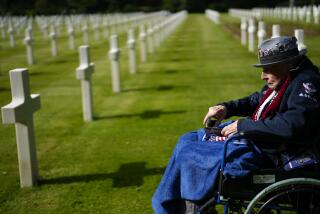Veterans Day: In New Orleans, flying machines tell the story of WWII
From the outside, the third and newest building at the National World War II Museum in New Orleans looks like an airplane hangar with a seven-story wall of glass that lets you see a few vintage planes hanging from the ceiling -- and not much else.
Inside is another story, a grand and amazing one.
Exit the elevator at the fourth floor of the U.S. Freedom Pavilion -- the Boeing Center, which opened in January -- and walk along the two-person-wide catwalk to eyeball the B-17 Flying Fortress, My Gal Sal. Its crew survived 10 days after an emergency landing in Greenland in 1942; volunteers worked 80,000 hours over more than 12 years restoring the aircraft.
Human and technical stories behind this and other warplanes are told through display cases containing bomber jackets and wartime paraphernalia -- and through earphones. The sounds reflect the era: Planes taking off and 1940s swing music (”No, no, no, it couldn’t be true that anyone would love you like I do.”)
Take your time to discover these and other smaller attractions inside the Freedom Pavilion:
--Oral-history videos of veterans, including Harry Connick, the singer’s father who was the longtime district attorney in New Orleans, or the mostly unknown Lavinia Breaux, one of the first African American women in the Women’s Army Corps, who talks about a close friend who died when a German U-boat sank her supply ship in the Gulf of Mexico in 1942.
--A wall of the 464 World War II Medal of Honor winners.
--You-are-there situations with ethical questions. Would you bomb a French rail yard and kill thousands of civilians, or spare them, which would mean more troops would die on D-day, June 6, 1944, when Allied troops landed on France’s Normandy beaches? Vote, then learn that yes, an officer ordered the bombing.
--Final Mission, well worth its $5 admission for a simulation of the sinking (by its own defective torpedo) of the U.S. submarine Tang in the South China Sea. Each “crew member” is given a card with the name of a real sailor, and a duty assignment as red warning lights flash and sound effects re-create the tragedy. Nine of the crew of 87 survived. Mine was one of them, and I felt relief.
National World War II Museum, 945 Magazine St., New Orleans 70130. Open 9 a.m.-5 p.m. daily. Pre-buy tickets, $13-$32. World War II veterans are admitted free.
More to Read
Sign up for The Wild
We’ll help you find the best places to hike, bike and run, as well as the perfect silent spots for meditation and yoga.
You may occasionally receive promotional content from the Los Angeles Times.






